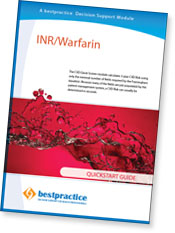INR

Introduction
International Normalised Ratio (INR) testing is well established as an integral part of warfarin treatment. INR has a critical role in maintaining the warfarin response within a therapeutic range, to provide the benefits of anticoagulation, while avoiding the risks of haemorrhage. The bestpractice Decision Support INR Monitoring module provides clinical support for health professionals in managing patients’ anticoagulant therapy.
Background
Warfarin is the most widely used anticoagulant in New Zealand. It has a valuable role in the prevention of thrombosis but the use of warfarin is associated with serious risks as it is the most frequent cause of adverse drug reactions in New Zealand.
An individual patient assessment addressing co-morbidities, medications and the ability to comply with monitoring is essential for the safe use of warfarin. Once the decision to use warfarin is made, prevention of bleeding complications relies on maintaining an INR within the recommended therapeutic range. To achieve this, appropriate monitoring and dose adjustments are required, as well as patient education to effectively manage any modifiable risk factors.
To ensure safe and effective anticoagulation for patients, a systematic and practice-wide approach is needed for warfarin therapy and the maintenance of INR levels within appropriate target ranges. The BPAC Inc web-based INR Monitoring module has been designed to support clinicians in achieving these goals.
How it works
The bestpractice Decision Support INR Monitoring module utilises a formula developed by Ryan et al. (BMJ 1989; Vol 299: 1207-1209) to calculate oral anticoagulant doses and recommend appropriate follow up times. By applying the Ryan algorithm (also known as the Coventry equation), dosing schedules are optimised to keep INR levels within the target range for each condition.
The INR monitoring module is designed for INR maintenance and not for initiation of warfarin therapy. If a patient has less than six INR result recorded in their records, the clinician will be prompted to confirm the patient is on a stable regime. The bestpractice Warfarin Initiation Protocol is available through the Resources tab.
Initial safety questions help monitor potential areas of concern so these can be investigated and noted in the patient’s record. The bestpractice INR module checks for any adverse reaction to therapy and on the patients’ general wellbeing such as a new illness such as fever or diarrhoea which may affect their warfarin therapy.
An erratic INR may reflect non-adherence to the drug regime often due to misunderstanding of dosage requirements. A missed dose of warfarin is usually reflected in the INR result 2 to 5 days after the missed dose, although a response may be seen within 16 hours.
Warfarin interacts with multiple other prescriptions medicines, as well as nutritional supplements, over-the-counter medicines and some foods e.g. foods that contain high levels of vitamin K such as broccoli, spinach and cabbage. Effects are more marked when starting, changing or stopping the dose. Quality patient information is available through the bestpractice Decision Support tool so patients can receive education about managing their warfarin therapy.
When the patient’s diagnosis is entered, the duration of treatment is calculated giving clinicians the INR target range for that condition. The patient’s INR result will be extracted from the practice management system or it can be entered manually. The module then immediately gives a dose recommendation and the date of the next recommended review.
The clinician can override a dose or review date if appropriate.
External links
- The warfarin dilemma, Best Practice Journal, October 2010. BPACNZ
- Use of INR for monitoring warfarin treatment, Best Tests, November 2010. BPACNZ
Featured module

The Patient Prompt module analyses the patient record at the time of consultation, providing notification of any areas where action may be required.
For more modules see the full list of standard modules.
Latest News
ACC18 Enhancements - Effective 27 November
Calendar, Printing and ACC Identifiers
In response to feedback, the online ACC18 continues to launch enhancements; the following will be available from 27 November.
Fitness for Work Tab - Calendar: Moving the mouse over the calendar for longer periods has been made easier.
Declaration Tab - ACC Identification: There will be a reduction in the number of identifiers from five to four; no direct impact on the Provider.
If you are one of the over 2000 Practitioners who regularly use the online ACC18; thank you. If you are not then now would be a good time to begin, noting that additional return to work assistance for patients is offered solely through this online form. Self service for setting up and using the online ACC18 is available at www.acc.co.nz (use keyword eACC18 Self Service). However, feel free to contact ACC at 0800 222 994 or ebusinessinfo@acc.co.nz for more personalised support.
Most Popular Modules
The five most popular modules in June were:
- Patient Prompt
- The Common Form
- e-Referral System
- ACC 18 Form
- CVD Quick Screen
To see more, go to the Statistics page.
Getting Started guide
The Getting Started guide is a good place to start if you are new to bestpractice Decision Support. The articles in the guide provide a quick and focussed introduction to the areas of most interest to new users of bestpractice.
About BPAC Inc
bestpractice Decision Support is produced by BPAC Inc. To find out more about us, click here.













